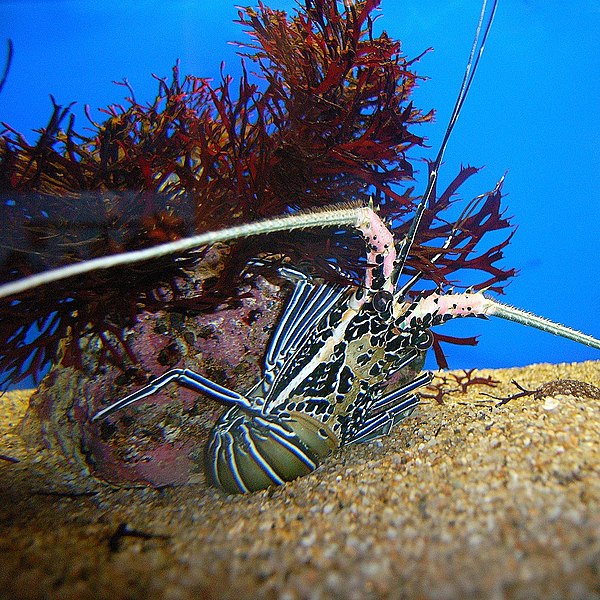Hello, Frank Indiviglio here. In Part I of this article we discussed general lobster care and took a look at the Dwarf Red or Hawaiian Reef Lobster, Enoplometopus occidentalis. Today I’ll introduce the Purple or Blue Spiny Lobster, Panulirus versicolor, and the Hawaiian Brown Slipper Lobster, Parribacus antarcticus.
Purple or Blue Spiny Lobster, Panulirus versicolor
 Related to the commercially valuable spiny lobsters of the Caribbean and Mediterranean, this white-dabbled, dark blue to purple beauty hails from the Indian Ocean.
Related to the commercially valuable spiny lobsters of the Caribbean and Mediterranean, this white-dabbled, dark blue to purple beauty hails from the Indian Ocean.
The 2-5 inch individuals commonly sold are quite popular, but it should be borne in mind that they can reach 8 inches in length, and, given their outrageously long antennae, require a large aquarium. The antennae break easily in crowded conditions, and, while they will regenerate, continually doing so likely saps the lobster’s strength.
While not as aggressive as smaller, heavily-clawed species, Purple Spiny Lobsters will consume other invertebrates and newly-molted tank-mates. Related species, usually drabber in color, sometimes appear in the trade, but these grow very large and are best left to commercial aquariums.
The Hawaiian Brown Slipper Lobster, Parrabacus antarcticus
Slipper Lobsters are quite unlike other species in appearance, being extremely compressed in body form. They live up to their alternative name, “Bulldozer Lobsters” and incessantly move substrate about in the wild and the aquarium. For that reason, care must be taken in setting up their living quarters, as they can easily crush themselves or their tank-mates during their “construction projects”. Heavy coral and rock should be placed on the aquarium’s floor, not on the substrate, to prevent their digging beneath.
Unfortunately, many of the Slipper Lobsters sold in the pet trade are the young of quite large species, and may reach 16 inches in length and weigh in excess of 10 pounds when mature (a number of these are commercially valuable food animals). The Hawaiian Brown Slipper Lobster, however, maxes out at 7-8 inches. It is, however, quite active and should not be crowded.
Hawaiian Slipper Lobsters are more sociable than most lobsters, and often congregate together. Newly-molted animals, however, may be attacked (please see Part I of this article). They are also less retiring than others of their kind, and often forage during the day.
Other Slipper Lobsters
Other species sometimes seen in the trade are the Spanish Slipper Lobster (Scyllarides aequinoctialis), (Range: South Carolina to Brazil) and the Vermillion Slipper Lobster, S. delfosi (Range: south Florida through the Caribbean). Lobster aficionados may also occasionally find S. martensi of Japan and the Philippine’s Ibacus ciliatus.
Further Reading
A video showing the Slipper Lobster’s unique mode of digging is posted here.
Please see Lobsters in the Marine Aquarium, Part I, for general husbandry information.
Please write in with your questions and comments.
Thanks, until next time,
Frank Indiviglio
Blue Spiny Lobster image referenced from wikipedia and originally posted by OpenCage
 That Fish Blog – Aquarium Advice and Information
That Fish Blog – Aquarium Advice and Information



cool post. I love to see different lobster species!